New Environmental Protection Equipment for Steel Drum Coating Production
Huizhou Huanfa Environmental Protection Technology Co., Ltd. – Wang Jianjun
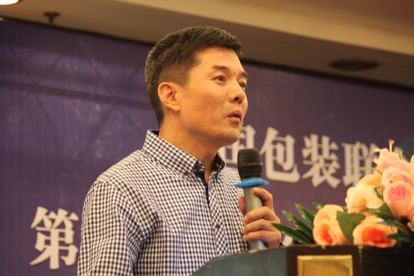
Wang Jianjun introduces new environmental protection equipment at the steel drum industry conference
Established in 2005, Huizhou Huanfa Environmental Protection Technology Co., Ltd. is located in Dayawan Economic and Technological Development Zone, Huizhou City, Guangdong Province. The company specializes in technical consultation for organic waste gas treatment, as well as the production, installation, commissioning, and operation of complete sets of environmental protection equipment. With over a decade of experience, the company has become a trusted name in the field of industrial pollution control.
Huanfa Environmental Protection is a member of both the Guangdong Provincial Environmental Protection Industry Association and the Huizhou Environmental Protection Industry Association. It holds the Guangdong Provincial Environmental Pollution Control Qualification Certification and has successfully passed the ISO9001:2008 International Quality Management System Certification. This ensures that its products and services meet the highest standards of quality and reliability.
The company is committed to fostering long-term cooperation between industry, academia, and research institutions. Huanfa has established technical partnerships with numerous domestic environmental protection enterprises, universities, and research institutes, as well as foreign organizations such as Spain’s APLICAT. Through extensive engineering practice, the company has developed innovative technologies, including the "ultraviolet photolysis-catalytic oxidation process for organic waste gas control." In traditional systems like the "Regenerative Thermal Oxidizer (RTO)," Huanfa has introduced "circulating concentration technology" and "thermal energy recycling," significantly reducing equipment size and project costs while improving energy efficiency and lowering operational expenses.
Huanfa Environmental's management philosophy is based on “Science and Technology Innovation Professional Services,†emphasizing the importance of innovation and high-quality service in the environmental protection sector.
**1. Regenerative Thermal Oxidizer (RTO)**
**What is RTO?**
RTO stands for Regenerative Thermal Oxidizer, a system used to treat volatile organic compounds (VOCs) by thermal oxidation. VOCs are organic chemicals that evaporate easily into the air, posing environmental and health risks.
**How does RTO work?**
The RTO works by heating the organic waste gas to temperatures above 760°C, ensuring that the VOCs are fully oxidized into harmless CO₂ and H₂O. The heat generated during this process is stored in ceramic regenerators and used to preheat incoming waste gas, significantly reducing fuel consumption and operating costs.
**Key Features of RTO Technology:**
- Applicable for high-concentration organic waste gas treatment (>2,500mg/m³)
- Available in two or three chamber configurations
- Treatment capacity: 2,000–60,000m³/h
- High treatment efficiency: 95–99%
- High heat exchange efficiency: up to 95%
- Low maintenance costs
- High degree of automation
**2. Working Process of Two-Chamber RTO Equipment**
Low-temperature exhaust gas enters the first regenerator, where it is heated by the ceramic media. It then flows into the oxidation chamber, where it is further heated by a burner to reach the required temperature (760–800°C). At this temperature, the VOCs are broken down into CO₂ and H₂O. The purified gas then passes through the second regenerator, releasing heat before being discharged through the chimney. After one cycle, the valves switch to reverse the airflow direction, continuing the process.
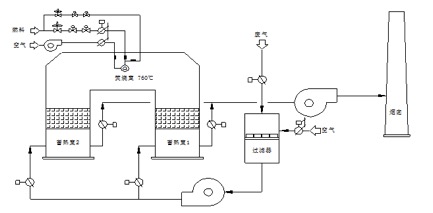
RTO device schematic
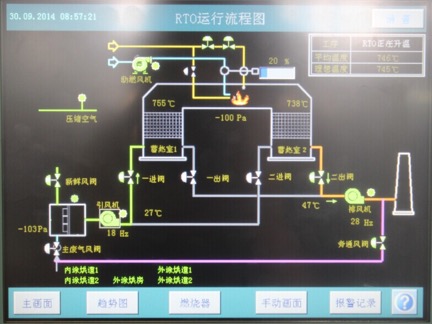
RTO device PLC control interface
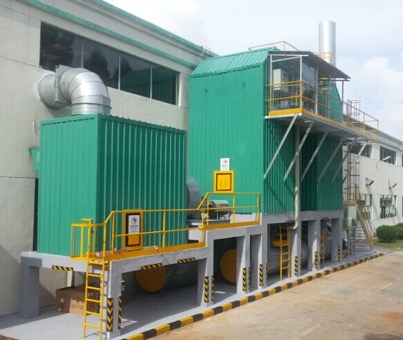
RTO project example: Greif (Huizhou) Packaging Co., Ltd.
**3. RTO Waste Heat Recovery**
The flue gas emitted from the RTO furnace is typically around 110°C, making it ideal for waste heat recovery. This recovered heat can be used in various ways:
- Reused in the drying room by exchanging heat with incoming air
- Used to produce hot water for factory dormitories
**II. Spray Room Exhaust Gas Circulation Concentration Device**
**Introduction to the Spray Room Exhaust Gas Circulation Concentration Device**
This device captures paint particles from the spray booth exhaust, removing over 97% of them. It then filters the remaining particles using a fiber filter. About 70% of the purified gas is returned to the spray booth, while the other 30% is sent to the purification system. This reduces the volume of gas processed by the purification unit by 70% and increases its concentration by three times, leading to lower equipment investment and operating costs.
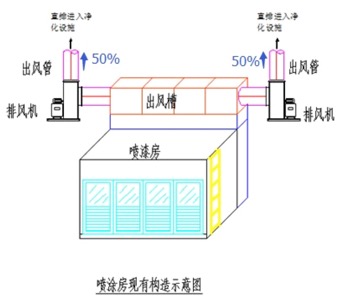
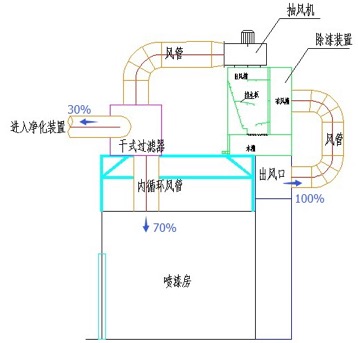
Comparison of ordinary spray booth vs. spray room with installed exhaust gas circulation concentrating device
**Working Principle of Spray Room Exhaust Gas Circulation Concentration Device**
The gas containing paint particles is drawn into the scroll chamber by an exhaust fan. Centrifugal force separates the paint particles from the air, which are then collected in a water trap. The mixture of paint particles and water is redirected back to the sink for reuse.
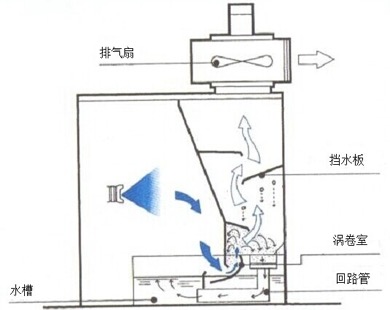
Spray room exhaust gas circulation concentrating device working principle diagram

Spray room exhaust gas circulation concentrating device physical map
**III. Activated Carbon Fiber Adsorption Recovery Unit**
Activated carbon fiber (ACF) is a newer form of activated carbon, known for its fast adsorption and desorption rates, ease of regeneration, and versatility in shape. Compared to traditional granular activated carbon, ACF offers better performance and easier handling.
**Features of Activated Carbon Fiber:**
- High adsorption capacity
- Fast adsorption and desorption speed
- Good heat resistance and chemical stability
- Easy to process into felt, cloth, paper, etc.
**Application of the Adsorption Recovery Unit**
This unit is widely used in industries such as petrochemical, printing, painting, coating, and pharmaceuticals. It effectively recovers solvents like benzene, toluene, xylene, acetone, and many others, allowing for their reuse or sale.
**Principle of the Adsorption Recovery Unit**
The process involves multiple adsorption chambers controlled by a microcomputer. Organic waste gas is filtered under reduced pressure and then adsorbed onto the activated carbon fiber. After reaching saturation, the gas is desorbed using steam, and the resulting mixture is condensed and separated. The recovered organic matter is stored for reuse, while the water is treated and discharged.
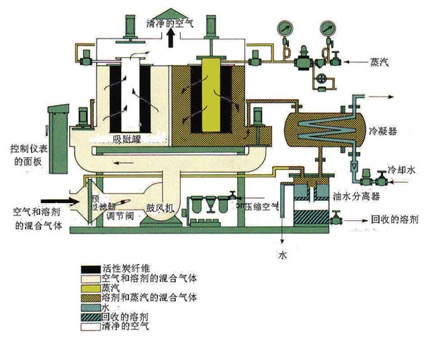
Process diagram of activated carbon fiber adsorption recovery unit
Aloe Oil,Jojoba Oil,Olive Oil,Cosmetics Essential Oil
Ji'An ZhongXiang Natural Plants Co.,Ltd. , https://www.zxessentialoil.com